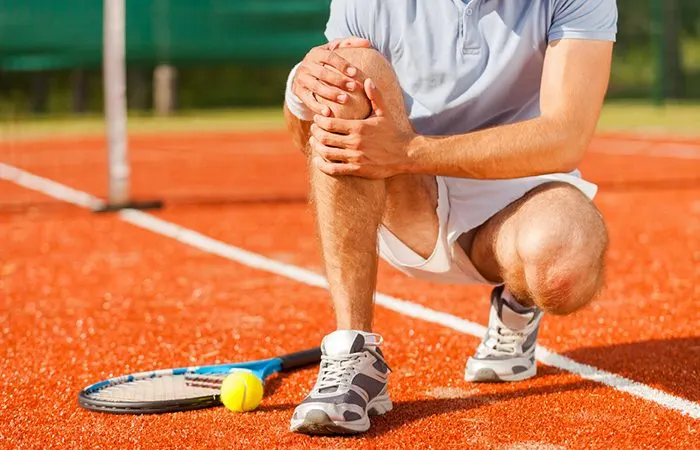Whether you’re a seasoned tennis player or just getting into it, odds are someone’s warned you about what the sport might do to your knees. And yeah—we’ve heard it too. “Tennis wrecks your knees.” “You’ll need a brace by 40.” Sound familiar?
But here’s the truth: tennis isn’t inherently bad for your knees. Like any sport, it comes down to how you move, how you train, and how you recover. At TruStrength, we work with a lot of athletes (recreational to pro) who love tennis—but they also want to keep their joints healthy for the long haul.
Let’s break down why your knees might hurt from tennis, what’s really going on underneath that discomfort, and what you can do to stay in the game without ending up on the sidelines.
Understanding the Knee Joint in Tennis
Your knee is one of the largest and most complex joints in your body. It’s built to hinge and rotate slightly, absorbing the forces that come with walking, running, squatting—and yes, playing tennis.
What makes tennis tricky is that it’s not just running in straight lines. The sport demands:
- Sudden deceleration and acceleration
- Rapid direction changes
- Lateral lunges
- Split steps and quick pivots
All of that loads the knee in dynamic ways, especially if there’s any underlying imbalance, stiffness, or past injury. Even though your knee is designed to handle stress, repetitive loading without proper support can lead to breakdowns—particularly in the cartilage, meniscus, or connective tissue.
Common Knee Issues in Tennis Players
If your knees are aching after a match, there’s usually a reason. Here are some of the most common conditions we see at TruStrength among tennis athletes:
1. Patellar Tendonitis (Jumper’s Knee)
That sharp ache just below the kneecap? Classic sign of patellar tendon overload. This happens from repeated jumping, lunging, or poor shock absorption—especially on hard courts. Over time, microtears and inflammation develop in the tendon.
2. Runner’s Knee (Patellofemoral Pain Syndrome)
This is more of a tracking issue—your kneecap doesn’t glide smoothly over the joint, often due to weak glutes, tight quads, or flat feet. It’s a dull, aching pain in the front of the knee that gets worse with stairs, squats, or prolonged activity.
3. Meniscus Tears
Quick pivots and twisting motions can put shear force on the meniscus (the knee’s cartilage pad), especially if you’re landing awkwardly or already have some wear and tear. You might feel locking, catching, or swelling.
4. Ligament Sprains (MCL/LCL)
Side-to-side motion and contact with the ground can stress the medial or lateral ligaments of the knee. While full tears are less common, sprains can limit mobility and increase instability—especially if left unaddressed.
5. Osteoarthritis Flare-Ups
If you’ve had past injuries or are in your 40s or 50s, tennis might aggravate early signs of knee arthritis. You’ll usually notice stiffness, swelling, or deep aching during or after playing.
Diagnosing What’s Really Going On
Pain is a signal—not a sentence. Just because your knees hurt doesn’t mean tennis is the villain. The key is figuring out what your body’s trying to tell you and taking steps to correct it.
Self-Check: Red Flags to Watch For
- Does your pain last longer than 24–48 hours after playing?
- Is it sharp, stabbing, or persistent during movement?
- Do you notice swelling, locking, or instability?
- Is one knee worse than the other?
- Are stairs, squats, or sitting painful even on rest days?
If you answered yes to any of these, it’s time to stop guessing. A proper movement assessment can reveal what muscles aren’t firing, what joints are compensating, and what’s really driving the issue.
Professional Evaluation at TruStrength
At TruStrength, we take a full-body approach. That means we don’t just look at the knee—we evaluate:
- Hip strength and mobility
- Foot mechanics
- Ankle range of motion
- Core control during movement
- Previous injury history
Knee pain is rarely just about the knee. It’s usually about how your whole system is (or isn’t) working together.
What You Can Do About Knee Pain From Tennis
If you’re dealing with knee discomfort, there’s good news: most tennis-related issues respond really well to the right interventions. Here’s how we approach it.
Short-Term Relief Strategies
- Ice & Elevation: For swelling or acute pain post-match.
- Compression Sleeves: Useful during activity for mild instability.
- Activity Modification: Switch to clay courts or reduce back-to-back matches temporarily.
Long-Term Fixes
This is where the real change happens:
1. Strength Training
Focus on strengthening the glutes, hamstrings, quads, and calves. We see too many tennis players with quad-dominant movement patterns, which overloads the knee. Fix that, and a lot of the pain disappears.
2. Mobility Work
If your ankles or hips are locked up, your knee ends up being the shock absorber. Loosening these areas with mobility drills is key to reducing stress at the joint.
3. Corrective Movement Coaching
We train clients to decelerate properly, use efficient footwork, and load their body evenly—especially during split steps, lateral movement, and serve returns. Movement patterns are everything.
4. Manual Therapy
Sometimes you need hands-on care. Soft tissue work, myofascial release, and dry needling (when appropriate) can reduce tension in the quads, IT band, and calves that pull on the knee.
5. Custom Recovery Plans
From personalized warm-ups to pre-match joint prep, our recovery programs are tailored to you. You’ll recover faster, feel stronger, and prevent issues before they start.
How to Prevent Knee Injuries from Tennis in the First Place
Even if you’re pain-free right now, you should absolutely be thinking about joint longevity. Here’s what we recommend:
- Invest in proper footwear: Your shoes matter. Make sure they’re supportive, court-appropriate, and changed out regularly.
- Warm up dynamically: Do NOT skip this. Focus on lateral hops, lunges, and glute activation before you play.
- Do cross-training: Tennis alone won’t build everything you need. Add in strength training and mobility days.
- Don’t play through pain: A little soreness is one thing—persistent pain is a red flag.
- Get regular movement check-ins: A quarterly evaluation with a movement specialist at TruStrength can catch small imbalances before they become big problems.
So… Is Tennis Bad for Your Knees?
It can be—but it doesn’t have to be.
Tennis is an incredible sport. It builds agility, cardio endurance, power, and coordination. But like any high-impact activity, it needs to be supported with smart training, proper movement mechanics, and recovery.
If your knees are starting to complain or you want to make sure you’re not setting yourself up for injury, don’t wait until you’re limping off the court.
Let the experts at TruStrength help you stay in the game—with less pain and more performance.
Ready to Protect Your Knees and Keep Playing?
At TruStrength, we specialize in helping athletes—of all ages and skill levels—move better, hurt less, and keep doing what they love. Our team can assess your movement, customize a treatment or prevention plan, and get your knees (and the rest of your body) working like they should.Whether you’re managing knee pain or just trying to avoid it, we’ve got your back—and your knees. Book your consultation with TruStrength now. Let’s get you back to playing pain-free.



